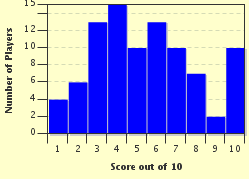Quiz Answer Key and Fun Facts
1. Bamanankan, known more commonly as Bambara, is spoken by the Bamana (or Bambara) people, and is of the Manding cluster of languages. In which of these countries is it regarded as the lingua franca, spoken by most of the population as a first or second language? This country's capital is a Bamanankan word meaning "crocodile river".
2. Cham is a language spoken by people of the same name in Southeast Asia, particularly in Cambodia and Vietnam. There are two main dialects; in Cambodia, Cham people speak Western Cham while those in Vietnam speak Eastern Cham. This division is also shown by the scripts used for each dialect. Eastern Cham is generally written in the Cham alphabet, while Western Cham uses which script?
3. Tigre is a language spoken mainly in Eritrea (where it is also known as Tigrayit) and Sudan (where it is called Xasa) by a people of the same name. As well as Arabic, it can be written in the Ge'ez script, which is used for various Eritrean and Ethiopian languages. To which language family does the Tigre language belong?
4. As Russia encompasses such a large area, it is no surprise that there are many different peoples and languages spoken in the largest country in the world. As well as Russian, there are more than 20 official languages in different regions of Russia, many named after the republics in which they are official. Which of these is NOT the name of a Russian republic and its official language?
5. A language isolate is one that has no demonstrable relationship or common ancestry with another known language. The Seri language is one such isolate, although it is sometimes grouped into the hypothetical Hokan language family. It is spoken by fewer than one thousand people in villages on the coast of Sonora in which country?
6. Which of these languages is a Sinitic language (related to Chinese) and is spoken particularly in Kazakhstan and Kyrgyzstan? It is written in Cyrillic and named for the people who speak it.
7. Khoekhoe is a Khoisan language, 20 of whose 31 consonants are clicks. The pejorative "Hottentot" is a former name for this language, which is a recognized national language in which of these African countries?
8. Various people have contributed to inventing a so-called "international auxiliary language", an artificial language used to ease communication between groups speaking different languages. Which of these is NOT one of these auxiliary languages?
9. Anuta (or Anutan) is a so-called Polynesian Outlier language, spoken on an island of the same name, which has also been called Cherry Island in English. Anutan has only eight consonants and is spoken by fewer than three hundred people; the island of Anuta is about eighty miles away from its nearest neighbor, Tikopia. In which country is it situated and is Anutan spoken?
10. Which of these languages, also called Judaeo-Spanish, is derived from Spanish, written in Hebrew, and spoken worldwide by the descendants of Sephardic Jews who were expelled from Spain in 1492?
Source: Author
reeshy
This quiz was reviewed by FunTrivia editor
trident before going online.
Any errors found in FunTrivia content are routinely corrected through our feedback system.

